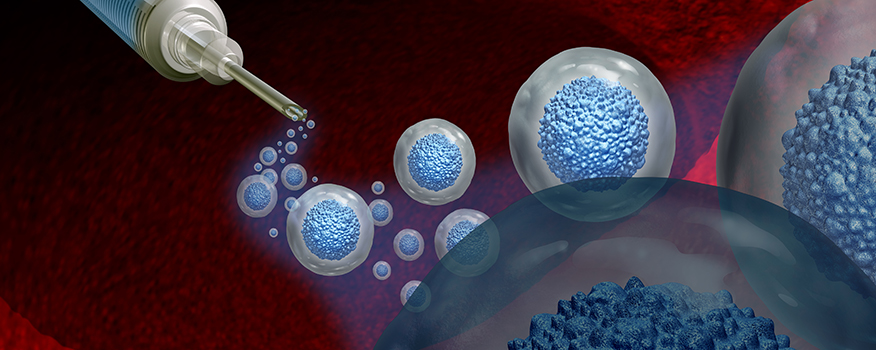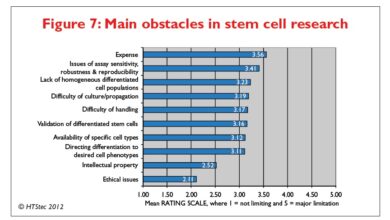
Regenerative medicine has bright future – Regenerative medicine has a bright future, promising to revolutionize healthcare and address a wide range of diseases and injuries. This exciting field harnesses the power of biological processes to repair or replace damaged tissues and organs. From groundbreaking stem cell therapies to sophisticated tissue engineering techniques, the potential applications are vast, offering hope for patients suffering from debilitating conditions.
This exploration delves into the fundamental principles, technological advancements, ethical considerations, and future trends shaping this rapidly evolving field. We’ll examine the potential economic impact, regulatory landscape, and public perception surrounding regenerative medicine. Join us as we uncover the multifaceted aspects of this transformative approach to healing.
Regenerative Medicine: A Promising Frontier
Regenerative medicine holds the tantalizing promise of repairing or replacing damaged tissues and organs, offering a potential cure for a wide range of diseases and injuries. This revolutionary field is pushing the boundaries of biology and engineering, harnessing the body’s inherent healing abilities to restore function and improve quality of life.The fundamental principles behind regenerative therapies revolve around stimulating the body’s natural repair mechanisms.
This involves manipulating cells, tissues, or organs to promote growth, differentiation, and regeneration. Techniques often involve stimulating stem cells, guiding tissue formation, and creating biocompatible scaffolds for tissue regeneration. This intricate interplay of biological and engineering principles is driving significant advancements in the field.
Historical Context and Evolution
Regenerative medicine’s roots lie in the understanding of tissue repair and the discovery of stem cells. Early studies focused on understanding the mechanisms of wound healing and the potential of embryonic stem cells. The development of sophisticated biomaterials and bioreactors has enabled researchers to create controlled environments for tissue growth and development. Advancements in gene editing and cell therapy technologies have further accelerated the field’s progress, paving the way for targeted therapies and personalized medicine approaches.
Types of Regenerative Medicine Approaches
Regenerative medicine encompasses diverse approaches, each with its own strengths and limitations. Cell-based therapies, for instance, utilize stem cells and other specialized cells to replace damaged or diseased cells. These therapies hold promise for treating conditions like heart disease, stroke, and diabetes. Tissue engineering, on the other hand, focuses on creating functional tissues or organs in the laboratory using biomaterials and cells.
This approach has shown potential for creating tissues such as cartilage, bone, and skin. Both methods have proven effective in preclinical trials, and are undergoing rigorous clinical evaluation for various conditions.
Key Challenges and Limitations
Despite the remarkable progress, regenerative medicine faces several hurdles. One significant challenge is ensuring the safety and efficacy of therapies. Ensuring the appropriate cellular or tissue integration within the patient’s body is crucial. The immune response of the recipient to transplanted cells or tissues is another critical concern. Ethical considerations surrounding stem cell sources and the potential for misuse of the technology must also be carefully addressed.
Furthermore, the high cost of developing and implementing these therapies often presents a barrier to widespread adoption. Finally, scaling up production to meet clinical demand remains a considerable hurdle.
Current Research Areas
Researchers are exploring numerous avenues within regenerative medicine, with promising results in several areas. One area is using bioprinting to create complex three-dimensional tissues and organs, opening doors for personalized therapies. Another is exploring the use of biomaterials to create scaffolds that mimic the natural extracellular matrix, providing a supportive environment for cell growth and tissue regeneration. In addition, there is growing interest in using gene therapy to modify cells, potentially enabling them to better perform their functions or promote regeneration.
Potential of Regenerative Medicine
Regenerative medicine, a rapidly evolving field, holds immense promise for transforming healthcare. It aims to repair or replace damaged tissues and organs, offering a novel approach to treating a wide spectrum of diseases and injuries. This transformative potential stems from its ability to address the root causes of disease, rather than just treating symptoms.The core principle of regenerative medicine is to harness the body’s own natural healing mechanisms to stimulate the growth of new tissues and organs.
Regenerative medicine holds so much promise for the future, offering potential cures for a wide range of diseases. Recent research, like a study on how psoriasis medication Otezla can lead to fat loss in people with psoriatic arthritis ( psoriasis medication otezla leads to fat loss in people with psoriatic arthritis study says ), highlights the exciting potential of targeted therapies.
This, in turn, further supports the bright future of regenerative medicine, paving the way for innovative treatments and improved quality of life for many.
This is achieved through a variety of strategies, from stimulating cell growth to using bioengineered scaffolds and stem cells. These advancements are not only addressing existing medical challenges but also opening up possibilities for treating previously incurable conditions.
Applications of Regenerative Medicine
Regenerative medicine offers a broad spectrum of applications, extending far beyond replacing damaged tissues. It’s a versatile field with potential to treat a wide array of diseases and injuries.
- Treating diseases like diabetes, heart disease, and neurological disorders, through therapies that stimulate the growth of new nerve cells or heart muscle tissue.
- Repairing injuries, such as spinal cord injuries, burns, and cartilage damage, by stimulating the body’s natural healing processes.
- Developing new drug delivery systems, allowing for targeted therapies to specific cells and tissues.
Examples of Successful Applications
Numerous examples showcase the efficacy of regenerative medicine techniques in various medical fields.
- Tissue Engineering: Researchers have successfully engineered functional tissues, such as skin grafts for burn victims, cartilage for joint repair, and even blood vessels. These advancements offer hope for patients with severe tissue damage and chronic conditions. The process involves cultivating cells on scaffolds to produce tissues that are compatible with the body’s natural tissues.
- Stem Cell Therapy: Stem cells, with their capacity to differentiate into various cell types, have emerged as a cornerstone of regenerative medicine. Successful applications include treating blood disorders like leukemia and treating some types of spinal cord injuries. The therapeutic potential of stem cells is enormous and is continually being explored in clinical trials.
- Gene Therapy: Gene therapy offers a precise approach to correcting genetic defects that cause disease. Successes include the treatment of some inherited blood disorders, demonstrating the potential to treat a broader range of genetic conditions.
Revolutionizing Healthcare
Regenerative medicine has the potential to revolutionize healthcare in several key ways.
- Improved Treatment Outcomes: By addressing the root cause of diseases and injuries, regenerative medicine can lead to improved outcomes for patients with a wide range of conditions, including those that were previously considered incurable.
- Reduced Reliance on Medications: In some cases, regenerative medicine could potentially reduce the need for long-term medications and invasive procedures, improving patient quality of life and minimizing side effects.
- Enhanced Efficiency: The development of regenerative therapies can potentially increase the efficiency of healthcare systems by reducing the need for lengthy hospital stays and costly procedures.
Factors Driving Advancement
Several factors are driving the rapid advancement of regenerative medicine.
- Advancements in Biotechnology: Innovations in cell culture techniques, bioprinting, and biomaterials have significantly enhanced the ability to create and manipulate cells and tissues.
- Improved Understanding of Biological Processes: A deeper understanding of cellular mechanisms and the processes of tissue regeneration is paving the way for the development of targeted therapies.
- Increased Funding and Research: Significant investment in research and development is fueling innovation and accelerating the pace of discoveries in regenerative medicine.
Different Regenerative Medicine Strategies
Various strategies are employed in regenerative medicine, each with its unique advantages and limitations.
- Stem cell therapy: Utilizes stem cells to regenerate damaged tissues and organs. This approach has shown promise in treating various conditions, but it also faces challenges like the ethical sourcing of stem cells and the potential for immune rejection.
- Tissue engineering: Combines cells and biomaterials to create functional tissues and organs. This technique holds potential for addressing a wide range of injuries and diseases. It requires careful selection of biomaterials and optimal growth conditions to ensure the structural integrity of the new tissue.
- Gene therapy: Targets genetic defects responsible for diseases by introducing or modifying genes. While gene therapy offers a powerful tool to correct genetic flaws, safety and ethical considerations remain important areas of focus.
Technological Advancements
Regenerative medicine is rapidly evolving, driven by groundbreaking advancements in various technologies. These innovations are transforming our understanding of tissue repair and disease treatment, paving the way for a future where damaged tissues and organs can be effectively restored. This dynamic field holds immense promise for addressing a wide range of health challenges, from spinal cord injuries to heart disease.These technologies, from stem cell therapies to 3D bioprinting, are increasingly sophisticated and effective, leading to a paradigm shift in healthcare.
Regenerative medicine holds so much promise for the future, offering exciting possibilities for treating a wide range of diseases. However, it’s important to remember that not everything that sounds groundbreaking is safe or effective. For example, a significant concern arises when people consider using pet prescription medications; it’s a terrible idea, and can have serious consequences. This article dives deep into the dangers of this practice.
Despite these potential pitfalls, the overall potential of regenerative medicine remains incredibly bright.
The focus on precision and control in these techniques is key to realizing the full potential of regenerative medicine.
Stem Cell Therapies
Stem cells, with their remarkable ability to differentiate into various cell types, are fundamental to regenerative medicine. They are pivotal in repairing damaged tissues by replenishing lost or dysfunctional cells. Different types of stem cells, including embryonic stem cells, induced pluripotent stem cells (iPSCs), and mesenchymal stem cells, exhibit varying degrees of differentiation potential and therapeutic applications. Researchers are actively exploring the potential of stem cells to treat conditions such as Parkinson’s disease, diabetes, and heart failure.
Clinical trials are ongoing to evaluate the safety and efficacy of stem cell therapies in diverse applications. For instance, mesenchymal stem cells have shown promise in treating osteoarthritis, with some studies reporting significant pain reduction and improved joint function.
Biomaterials and Scaffolds in Tissue Engineering
Biomaterials and scaffolds play a crucial role in tissue engineering by providing a supportive structure for cell growth and tissue regeneration. These materials are designed to mimic the natural extracellular matrix, offering a conducive environment for stem cells to proliferate and differentiate into desired cell types. Hydrogels, polymers, and natural materials like collagen and silk are frequently used in scaffold development.
Researchers are exploring biomaterials with improved biocompatibility, biodegradability, and mechanical properties to enhance the efficacy of tissue engineering approaches. For example, the use of biodegradable polymers allows for gradual scaffold resorption, enabling the body to seamlessly integrate the regenerated tissue.
3D Bioprinting Technologies
D bioprinting is a revolutionary technique in regenerative medicine, enabling the creation of complex, three-dimensional tissues and organs layer by layer. This technology allows for precise control over cell placement, scaffold architecture, and tissue structure. By combining bioinks (biocompatible materials containing cells) with 3D printing, researchers can fabricate tissues with specific geometries and functionalities. The precise placement of cells ensures that the resulting tissues function optimally.
Regenerative medicine definitely has a bright future, promising revolutionary treatments for various ailments. A fascinating development in this field is the emergence of new tools to help monitor health. For instance, a new app, new app monitors the health of pregnant women , provides real-time data and personalized insights, potentially improving maternal health outcomes. Ultimately, these advancements in both monitoring and treatment will further propel regenerative medicine’s exciting potential.
For instance, 3D bioprinted tissues could be used to create functional skin grafts for burn victims, offering a personalized and customized solution.
Nanotechnology in Regenerative Medicine
Nanotechnology offers a new dimension in regenerative medicine, enabling the development of targeted drug delivery systems and enhanced tissue regeneration. Nanomaterials, with their unique properties, can be engineered to deliver therapeutic molecules directly to diseased tissues or cells, maximizing efficacy and minimizing side effects. Nanoparticles can be designed to carry drugs, genes, or growth factors, delivering them precisely to the site of injury or disease.
Researchers are developing nano-scale scaffolds and bioinks, which can be incorporated into 3D bioprinting techniques, to improve tissue regeneration. For example, gold nanoparticles have been explored as a means of delivering therapeutic agents to specific cells in the body.
Ethical Considerations: Regenerative Medicine Has Bright Future

Regenerative medicine, while holding immense promise, presents a complex array of ethical challenges that must be carefully addressed. The potential to repair or replace damaged tissues and organs raises profound questions about the responsible development and application of these technologies. From the source of the cells used to the societal impact of widespread access, careful consideration of the ethical implications is crucial for ensuring the field’s positive impact.The potential for significant advancements in healthcare and improved quality of life is undeniable, yet these advancements also introduce new ethical considerations.
Balancing the benefits with the potential risks and societal implications is paramount to ensure responsible and equitable access to these potentially life-altering treatments.
Ethical Dilemmas Surrounding Regenerative Medicine
The field of regenerative medicine faces a multitude of ethical dilemmas. These dilemmas range from the source of materials used in the process to the potential for misuse or inequitable access. The use of embryonic stem cells, for example, often elicits strong ethical concerns related to the destruction of potential human life.
Implications of Regenerative Medicine on Society
Regenerative medicine’s impact on society will be substantial. Increased lifespan and improved quality of life are possibilities. However, the societal implications are multifaceted and require careful evaluation. Potential economic disparities, changes in healthcare systems, and the distribution of resources are all important considerations. Access to these therapies will be a critical factor, with equitable distribution becoming a significant societal challenge.
Ethical Issues Concerning the Use of Stem Cells
Stem cells, the building blocks of tissue regeneration, raise crucial ethical concerns. The source of these cells is a major point of contention. Embryonic stem cells, derived from human embryos, raise significant ethical questions regarding the moral status of the embryo. Adult stem cells, while posing fewer ethical issues related to the embryo, may still present difficulties related to their limited availability and potential for rejection.
Induced pluripotent stem cells (iPSCs), derived from adult cells, offer a potential solution, but their safety and efficacy remain subjects of ongoing research.
Potential Risks and Controversies Related to Regenerative Therapies
The application of regenerative therapies carries potential risks and controversies. Ensuring the safety and efficacy of these treatments is paramount. The possibility of immune rejection, the potential for tumor formation, and the long-term effects of the therapies are crucial areas of concern. Public trust and transparency are vital for the responsible advancement of the field. Addressing these concerns requires rigorous testing, transparent reporting, and careful consideration of the potential risks.
Comparison of Ethical Considerations Across Regenerative Medicine Approaches
| Approach | Source of Cells | Ethical Concerns | Potential Risks |
|---|---|---|---|
| Embryonic Stem Cell Therapy | Human embryos | Destruction of potential human life, embryo research regulations | Immune rejection, tumor formation, ethical controversies |
| Adult Stem Cell Therapy | Adult tissues (bone marrow, adipose tissue) | Limited availability, potential for rejection | Lower risk of immune rejection compared to embryonic stem cells |
| Induced Pluripotent Stem Cell (iPSC) Therapy | Adult cells reprogrammed | Ethical concerns regarding the reprogramming process, potential for genetic mutations | Potential for tumor formation, long-term safety not fully established |
| Tissue Engineering | Various biomaterials, cells | Material safety, cell source ethics, potential for infection | Potential for material rejection, inflammation, lack of long-term data |
Future Trends and Predictions
Regenerative medicine is poised for significant advancements in the coming years. The convergence of scientific breakthroughs, technological innovation, and a growing understanding of biological processes promises a future where damaged tissues and organs can be repaired or even replaced. This transformation will reshape healthcare, offering new hope for patients with a wide range of conditions.
Emerging Trends in Regenerative Medicine
Several key trends are shaping the future of regenerative medicine. These include the increasing use of stem cell therapies, advancements in bioprinting technologies, and the growing importance of personalized medicine approaches. The development of more sophisticated biomaterials and scaffolds will also play a crucial role in creating supportive environments for tissue regeneration.
Future Direction of Regenerative Medicine Research
Research in regenerative medicine is likely to focus on developing more effective and versatile stem cell therapies. This includes exploring novel methods for directing stem cell differentiation and improving the efficiency of their integration into damaged tissues. Further advancements in bioprinting techniques will allow for the creation of complex, functional tissues and organs on demand, offering tailored solutions for specific patient needs.
Researchers will also prioritize understanding the intricate signaling pathways that regulate tissue regeneration, potentially unlocking novel therapeutic targets.
Potential of Personalized Medicine in Regenerative Therapies
Personalized medicine is expected to play a crucial role in regenerative therapies. By analyzing individual genetic profiles and environmental factors, clinicians can tailor regenerative treatments to specific patient needs. This approach will lead to more effective and personalized stem cell therapies, optimized biomaterial scaffolds, and tailored strategies for tissue engineering. The development of diagnostic tools that identify patient-specific factors influencing regenerative outcomes will be critical.
Role of Artificial Intelligence in Regenerative Medicine
Artificial intelligence (AI) is poised to revolutionize regenerative medicine. AI algorithms can analyze vast datasets of biological information, identify patterns, and predict outcomes. This will enable researchers to optimize stem cell differentiation protocols, design personalized biomaterials, and accelerate the development of novel therapies. AI-powered tools can also enhance drug discovery efforts, accelerating the identification of new therapeutic targets.
Potential Impact of Future Trends on the Healthcare Industry
| Trend | Impact on Research | Impact on Clinical Practice | Impact on Healthcare Costs |
|---|---|---|---|
| Advanced Stem Cell Therapies | Increased efficiency and efficacy of regenerative protocols. | More effective treatments for a wider range of conditions. | Potential for long-term cost savings through reduced need for organ transplants. |
| Bioprinting Technologies | Creation of complex, functional tissues and organs. | Customized tissue and organ replacements for patients. | Potential for decreased healthcare costs in the long term. |
| Personalized Medicine | Development of targeted therapies based on individual patient profiles. | More precise and effective treatments for patients. | Potential for reduced healthcare costs by improving treatment outcomes. |
| Artificial Intelligence | Accelerated drug discovery and treatment development. | Improved diagnostics and personalized treatment plans. | Potential for cost savings through increased efficiency and reduced errors. |
Public Perception and Acceptance
Regenerative medicine holds immense promise for treating a wide array of diseases and injuries, but its widespread adoption hinges on public acceptance. Public perception is a crucial factor in shaping the future of this field, influencing funding, research priorities, and ultimately, patient access to these innovative therapies. Understanding the nuances of public opinion is vital for maximizing the potential of regenerative medicine and ensuring its responsible development.
Public Perception of Regenerative Medicine
Public perception of regenerative medicine is often a mixture of excitement and apprehension. Many view it as a groundbreaking advance with the potential to revolutionize healthcare, while others express concerns about safety, efficacy, and ethical implications. This complex interplay of positive and negative perceptions needs careful consideration to cultivate trust and encourage wider adoption.
Factors Influencing Public Acceptance
Several factors influence the public’s acceptance of regenerative therapies. These include the perceived risk and benefits of the specific therapy, media coverage, and the transparency of the research and development process. Furthermore, cultural and religious beliefs play a significant role in shaping attitudes towards interventions that involve biological modification or enhancement. Public trust in the scientific community and healthcare providers also directly impacts the willingness to embrace regenerative medicine.
Challenges in Communicating Benefits and Risks, Regenerative medicine has bright future
Communicating the complexities of regenerative medicine to the public effectively presents a significant challenge. The scientific language used in research papers and clinical trials often makes it difficult for the average person to grasp the nuances of the technology. Presenting potential benefits and risks in a balanced and understandable way, avoiding sensationalism or oversimplification, is crucial for fostering informed public dialogue.
Misinformation and misconceptions spread through social media and other channels further complicate the communication process.
Strategies to Foster Public Trust and Understanding
Building public trust and understanding of regenerative medicine requires a multi-faceted approach. This includes transparent communication about research findings, the involvement of patient advocates and community leaders in the development and implementation of new therapies, and educational initiatives to dispel myths and promote informed discussions. Public engagement through workshops, online forums, and interactive exhibits can facilitate a deeper understanding of the field and address public concerns directly.
Demonstrating a commitment to ethical practices and regulatory oversight is paramount to building public trust.
Comparison of Public Perceptions of Regenerative Medicine Approaches
| Regenerative Medicine Approach | General Public Perception (Positive) | General Public Perception (Negative) | Demographics with Potentially Higher/Lower Acceptance |
|---|---|---|---|
| Stem Cell Therapy | High potential for treating various diseases; hope for cures | Safety concerns; ethical dilemmas regarding source of stem cells; long-term efficacy unknown | Younger populations, those facing debilitating diseases; religious groups with specific views on stem cell research |
| Gene Therapy | Potential for eliminating genetic diseases; personalized medicine | Safety and long-term effects; ethical considerations of altering the human genome; potential for unintended consequences | Families with genetic disorders; those interested in personalized medicine; individuals concerned about disease prevention |
| Bioprinting | Creation of functional tissues and organs; potentially addressing organ shortage | High cost; technological limitations; ethical questions about creating “artificial” organs | Patients with organ failure; researchers; individuals interested in advanced technologies |
Economic Impact
Regenerative medicine holds immense promise for transforming healthcare and improving lives, but its true potential hinges on its economic viability. Understanding the economic implications, including job creation, market trends, and investment opportunities, is crucial for fostering innovation and widespread adoption. This sector’s success hinges on a delicate balance between scientific advancement, financial investment, and societal acceptance.
Economic Implications of Regenerative Medicine
The economic impact of regenerative medicine is multifaceted, spanning various sectors. It’s not just about treating diseases; it’s about creating new industries, boosting employment, and driving economic growth. The potential for groundbreaking treatments and therapies translates into substantial economic benefits.
Potential for Job Creation and Economic Growth
Regenerative medicine is a burgeoning field, creating numerous opportunities for employment across diverse disciplines. From research scientists and engineers to clinical technicians and healthcare professionals, the sector necessitates a skilled workforce. The demand for specialized personnel, such as regenerative medicine specialists and tissue engineers, is poised to grow substantially. The development and manufacturing of regenerative medicine products also create jobs in the pharmaceutical and biotech industries.
This expansion can revitalize local economies and foster innovation hubs.
Market Trends for Regenerative Medicine
Current market trends indicate a strong interest in regenerative medicine. Growth is driven by the increasing prevalence of age-related diseases, the rising demand for minimally invasive procedures, and the continuous improvement of existing technologies. Companies are focusing on developing therapies for conditions like osteoarthritis, spinal cord injuries, and heart disease, driving market expansion. Further, the focus is shifting towards personalized medicine, where treatments are tailored to individual patients’ needs.
This personalized approach has the potential to enhance treatment efficacy and reduce adverse effects.
Estimated Market Size for Regenerative Medicine
Estimating the precise market size for regenerative medicine in the next decade is challenging, but forecasts suggest significant growth. Factors such as technological advancements, regulatory approvals, and public acceptance will play a critical role. For instance, the market for stem cell therapies is expected to grow rapidly, with projections of substantial revenue generation. This growth is anticipated to be driven by increased research and development efforts, coupled with favorable regulatory outcomes.
Potential Investment Opportunities
The regenerative medicine industry presents compelling investment opportunities across various stages of development. Investing in early-stage companies developing innovative therapies can yield high returns, but carries higher risk. Conversely, established companies with proven track records offer more predictable returns.
| Investment Stage | Company Type | Potential Return | Risk Level |
|---|---|---|---|
| Early-Stage Research | Startups developing novel therapies | High | High |
| Clinical Trials | Companies conducting clinical trials | Moderate | Moderate |
| Commercialization | Established companies with approved products | Moderate | Low |
| Manufacturing and Distribution | Companies involved in scaling production | High | Moderate |
Regulatory Landscape
Navigating the complex world of regenerative medicine requires a robust regulatory framework. This framework must strike a balance between encouraging innovation and ensuring patient safety. The intricate process of bringing new therapies to market necessitates a thorough understanding of the regulatory landscape, particularly concerning the unique challenges presented by this rapidly evolving field.The regulatory framework governing regenerative medicine is a patchwork of guidelines, regulations, and policies, varying significantly across different countries and jurisdictions.
This diversity presents a significant hurdle for researchers and companies seeking to develop and commercialize new regenerative medicine therapies. It also raises complex questions regarding international collaboration and harmonization of standards.
Regulatory Frameworks in Different Countries
The regulatory landscape for regenerative medicine varies significantly across countries. Some countries, like the United States, have a more decentralized approach, with different agencies overseeing different types of therapies. Other countries, like the European Union, have a more centralized approach, with a single regulatory body overseeing the approval process. This difference in approach influences the speed and efficiency of the regulatory review process and the types of therapies that are prioritized.
- United States: The Food and Drug Administration (FDA) plays a crucial role in regulating regenerative medicine products. The FDA’s approach often involves a tiered evaluation process, with different levels of scrutiny based on the complexity and risk associated with the therapy. For example, therapies involving cellular therapies are often evaluated with a higher level of scrutiny than therapies using biomaterials.
This can impact the time to market and the cost of development for regenerative medicine products.
- European Union: The European Medicines Agency (EMA) is the primary regulatory body for medicinal products in the EU. The EMA’s regulatory framework for regenerative medicine products is more comprehensive than that of the US FDA. The EMA’s approach tends to emphasize a more holistic evaluation, encompassing both clinical efficacy and safety considerations.
- Canada: Health Canada oversees the approval process for regenerative medicine products. Health Canada’s approach to regulating regenerative medicine is similar to the FDA’s, with a focus on safety and efficacy. The regulatory pathway for new regenerative medicine products is typically longer and more complex compared to traditional pharmaceuticals.
Challenges in Regulating New Technologies
Regulating new regenerative medicine technologies presents unique challenges. The rapid pace of innovation in this field often outpaces the regulatory framework’s ability to keep up. The complexity of these technologies, encompassing biological processes and cellular engineering, also complicates the assessment of both safety and efficacy.
- Defining Safety and Efficacy: Defining appropriate standards for safety and efficacy for novel regenerative medicine therapies is difficult. Clinical trials must demonstrate not only the effectiveness of the therapy but also its long-term safety profile, which can be challenging given the evolving nature of the treatments.
- Data Requirements: The sheer volume of data needed to support the safety and efficacy of regenerative medicine products can be overwhelming. Gathering and analyzing this data from clinical trials and pre-clinical studies requires substantial resources and expertise.
- Standardization: Standardization of manufacturing processes and quality control for regenerative medicine products is essential for consistent safety and efficacy. Developing and enforcing these standards across different countries and laboratories is a significant hurdle.
Impact of Regulatory Decisions
Regulatory decisions profoundly influence the advancement of regenerative medicine. A supportive regulatory environment encourages innovation, attracting investment and research efforts. Conversely, stringent or unclear regulations can stifle progress, leading to delays and potentially preventing the development of life-saving therapies. A balance must be struck between fostering innovation and maintaining patient safety.
Process for Obtaining Regulatory Approvals
The process for obtaining regulatory approvals for regenerative therapies can vary depending on the specific therapy and the regulatory authority involved. Generally, it involves a multi-stage process, including pre-clinical studies, clinical trials, and regulatory submissions.
- Pre-clinical studies: These studies aim to assess the safety and potential efficacy of the therapy in animal models. These studies are crucial for determining the feasibility of the therapy and identifying potential safety concerns before human trials.
- Clinical trials: Clinical trials in humans are essential for assessing the safety and efficacy of the therapy in a controlled setting. These trials involve various phases, from small pilot studies to large-scale trials.
- Regulatory submissions: Once the clinical trials are completed and the data is analyzed, regulatory submissions are made to the relevant authorities. These submissions contain comprehensive information about the therapy, including data from pre-clinical studies and clinical trials.
Closure

In conclusion, regenerative medicine’s bright future is illuminated by remarkable advancements, promising a new era in healthcare. While ethical considerations and regulatory challenges remain, the potential for personalized therapies, improved treatments, and enhanced quality of life is undeniable. The journey ahead promises exciting discoveries and significant breakthroughs, ultimately impacting countless lives in the years to come.





